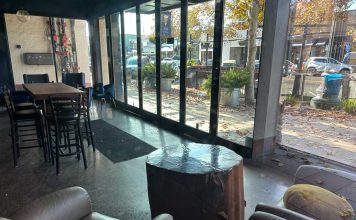30 Mexican firefighters head to San Jose for training; two stay
at Chestnut Station
Gilroy – They are called bomberos in Mexico. Most of the scare equipment they have is about 30 years behind California standards and donated by the United States. It was only three years ago that firefighters in Tecate, Mexico would enter smoke filled buildings without air tanks – just with bandanas wrapped around their noses. And only recently did firefighting become considered a noble profession.
Thirty bomberos traveled to San Jose last week for the 11 annual international training conference sponsored by The National Association of Hispanic Firefighters. Departments from across Santa Clara County volunteered to house them. Gilroy Fire Department put two firefighters from Tecate, Capt. Daniel Idelfonso Cervantes and Firefighter/Engineer Gregorio Javier Rocha, up at Sunrise Fire Station.
“A lot of things we just take for granted. To me, it’s honorable for these guys to come up here and learn about the best that we have to offer and have them take it back to their countries,” said Firefighter/Paramedic Heinz Maibaum.
For years Gilroy firefighters have donated used equipment including boots, gloves, and turnouts to Mexican fire departments.
“It’s old to us, but it’s new to them,” Maibaum explained. “They don’t have the means to have the type of training we have here. It gives us a better appreciation for our technology.”
For instance, the newest engine the Tecate department owns is 20 years old. The best tool they have – a reciprocating saw – GFD has been using for decades. They have a 75-pound spreader used to extricate individuals trapped in a vehicle.
“We consider that old, outdated – a risk to our firefighters,” Maibaum said. The bomberos use another twice the size. “Just showing these guys around – we’re benefiting from them being here. I think it takes a lot of courage for these guys to come up here. It’s a drastic change from what they have down there.”
According to Capt. Cervantes, Tecate’s fire chief is considered a political position. Every three years, as the politicians rotate – so does the chief. The current chief has no experience fighting fires. He is a reporter.
“Usually we have to pay out of pocket (for equipment),” he said through an interpreter. “It’s been years since the city provided equipment.”
It is not uncommon that for the last three months of the chief’s term that they do not have enough money to put gas in the fire engine.
“Anything that we can learn and take back is going to be of some value,” Cervantes said.
The bomberos receive training California firefighters use over the course of the week. The individuals sent to San Jose to learn the techniques will then teach the practices to departments when they return.
“We would probably benefit more from going there than them coming here,” said Capt. Joshua Valverde. “They’re making the same job happen with less.”
The bomberos must improvise with the limited equipment they have, he explained.
“You sit down and after 10 minutes it’s like you have known each other for 30 years,” he said. “You have the same common factor. You’re performing the same job, just with different means.”
Two months ago the department received a machine that allows them to refill their air tanks. Previously they went to the Tecate beer factory for refills.
They don’t have hydrants outside downtown. And sometimes there isn’t water pressure in the hydrants they do have.
But despite the obvious the differences – there are many similarities between the two departments.
According to Rocha, the camaraderie is the same.
But there is something more. Lifting his sweatshirt with the logo of his department, he reveals a New York Fire Department T-shirt.
“Much like it did here, (9/11) had a positive effect on the way public services were looked at,” he said. “In general, the fire service earned a lot more respect.”














